With Kilauea going crazy on the big island of Hawaii, our visit to the volcano goddess Pele just prior to this most recent eruption has taken on a new significance.
Truth be told, this is an incredibly active volcano and was erupting while we were there, just with much less intensity. In fact, it has been erupting non-stop since 1983, so this recent event is really only an escalation in magnitude.
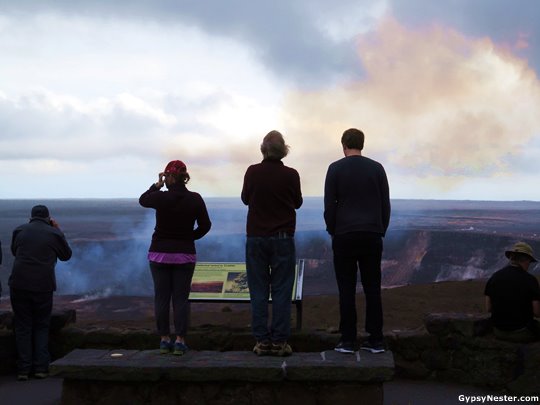
Since things were a lot less explosive at that time, we were able to visit Volcanoes National Park and stand on the rim of the crater overlooking the lake of liquid lava.
Not only did we get that chance, we were actually able to go beneath the earth’s surface inside the volcano’s network of lava tubes. Yes, we were technically inside of an erupting volcano!
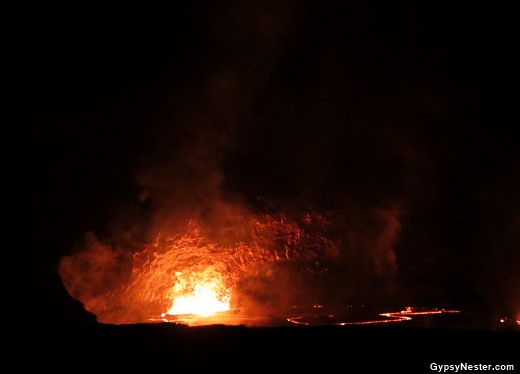
If that sounds a bit intense, it is.
We began with an introductory level cave right near the park’s observatory. The Thurston Lava Tube, named for Lorrin Thurston who discovered it in 1913. This is a great starter tube, and thus we initiated our education in volcano geology.
The caverns are formed when a lava flow develops crust that forms a roof over the flowing lava torrent. As the super-heated core of lava flows ahead, walls develop and finally the liquid drains downhill leaving long tunnels.
While this phenomenon occurs all over the world, anywhere that has shield type volcanic activity, no other place on Earth has as many accessible lava tubes as Hawaii.

The Thurston tube has an easy entry and well-lit pathway throughout, which made it comfortable and stress-free to walk the length of the passage without crouching or stooping. Not so at our next spelunking experience.
At the Kilaueu Caverns of Fire, we got a look at the undisputed big daddy of underground volcanic formations. We would be descending into an arm of the Kazamura Lava Tube system. At over forty miles long, this is the longest and deepest connected complex of lava tubes in the world.
After a short walk through the tropical forest, we carefully climbed down some rocky rubble into a small break in the ground.
That narrow gap, known as the mouth of the dragon, led to a dark cavern which looked to be untouched by the outside world.
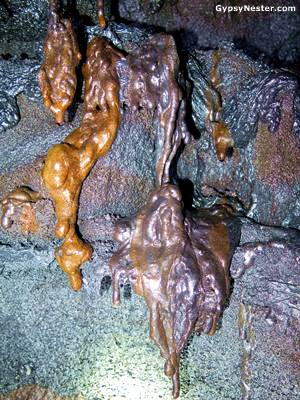
Equipped with helmets and lights we ventured forth slowly, allowing our eyes to adjust. When we could see clearly again, one of the first things we noticed was the variations in the colors and textures on the surfaces within the tube.
These were left behind by many different eruption events over time, all flowing within the same cave.
As each river of liquid rock passed through, it left behind a coating and tell-tale marks at the varying depths of the flows.
Each eruption also contained distinctive differences in the mineral makeup of the molten magma, which is evident in the coloration of the rock left behand after things cooled off.
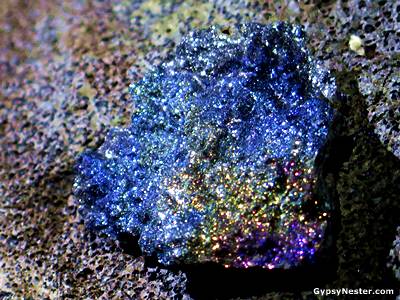
The classic look of black lava dominated the much of the tube, but a good amount of the surface had a rusty reddish-brown tint, created by iron in the lava. Other places had traces of many more hues that jumped out at us as they caught our beams of light.
Traces of nickel, copper, lead, manganese, zinc, sulphur, aluminum, or many other elements can leave colorful fingerprints in the stone.
We also learned that over the centuries native Hawaiians commonly used these caves as living quarters, or as refuge shelters to hide women, children, and elders during wars. Any artifacts left behind in this particular cave were long gone, but as many as half of the discovered tubes in Hawaii have contained relics.
The deeper into the tunnel we ventured, the more the ceiling of the tube closed down upon us. It wasn’t long until we could no longer crouch low enough to move ahead and were relegated to crawling on our hands and knees.
Finally, our way forward was dissected by two floors a few feet on top of each other, leaving little room for people. They had been created by separate flows and, while very cool to see, the bi-level flooring compelled us to turn around and go back the way we came.
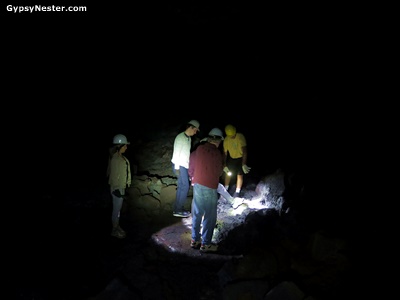 Before leaving though, our guide asked us to try a little experiment. We all turned off our lights and were amazed by the complete lack of any illumination. This is not something that most modern humans ever encounter in their daily routines. There is always at least some small source of light available to us.
Before leaving though, our guide asked us to try a little experiment. We all turned off our lights and were amazed by the complete lack of any illumination. This is not something that most modern humans ever encounter in their daily routines. There is always at least some small source of light available to us.
We have to admit that without any visual stimulus, we were somewhat disoriented… in fact, more than somewhat. With gravity as our only guide as to which way was up or down, and absolutely no clues to directions beyond that, it didn’t take long before we no idea which way to go.
It’s a good thing our lights came back on; otherwise we would probably still be down there trying to find our way out.
David & Veronica, GypsyNester.com



Very informative. Keep up the good efforts.
Like!! Great article post.Really thank you! Really Cool.
That must have been a great experience…walking in an active volcano.
Your blog is amazingly comprehensive. I am subscribing to your blog and look forward to future post! Keep up the great work
Thanks to the author for sharing this impressive blog. Really glad to read this article. This site has lots of information and it is useful for us.
AMAZING BLOG SIR
THANKS FOR SHARING IT
KEEP GOING !